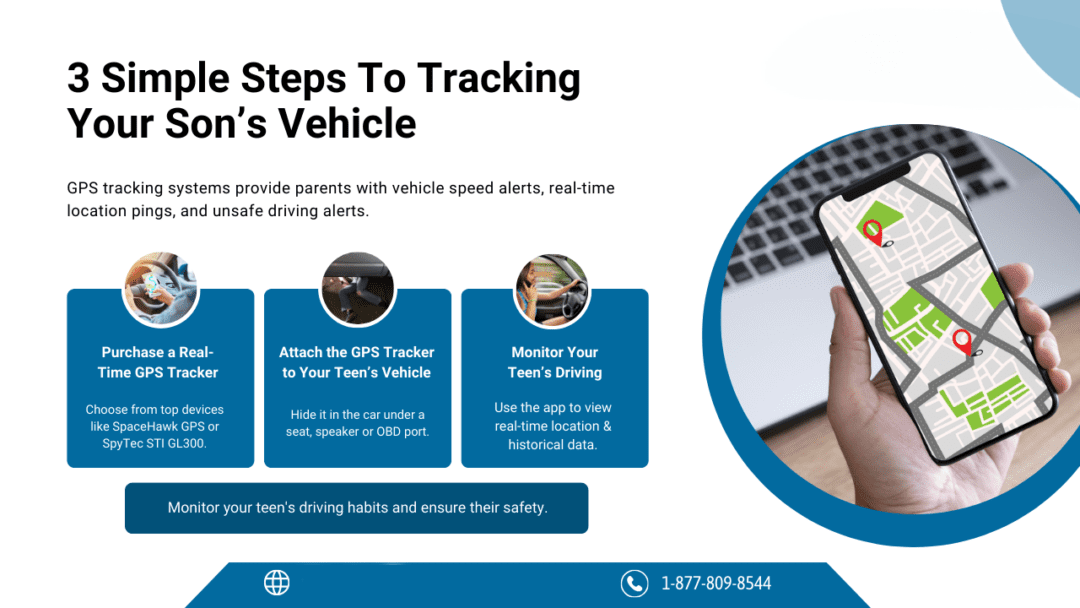The moment your teen grabs the car keys, your control slips away—and with it, your peace of mind. Speeding, distractions, reckless decisions—every mile they drive feels like a gamble with their safety. But what if you could stop disaster before it starts? What if you had a secret weapon to protect them, even when you’re not there?
In this article, you’ll uncover the power of GPS trackers to keep your teen safe on the road. Here’s what you’ll learn:
- How to stop speeding before it starts—real-time alerts let you act fast, turning risky behavior into teachable moments.
- Why location tracking is your ultimate safety net—know exactly where they are, without the endless texts or unanswered calls.
- The secret to balancing trust and safety—use technology to protect, not punish, and build a stronger relationship in the process.
This isn’t just about tracking; it’s about peace of mind. By the end, you’ll have the tools to protect your teen, reduce your anxiety, and ensure they stay safe—no matter where the road takes them. The solution is here. Let’s get started.
Addressing Speeding with Real-Time Monitoring
Your heart skips a beat as you think about your teen hitting the gas pedal, racing down unfamiliar roads without a second thought. One reckless decision could lead to devastating consequences.
Speeding isn’t just dangerous—it’s one of the deadliest mistakes teen drivers make. Fortunately, GPS teen driving monitors offer a lifeline for parents desperate to keep their kids safe. With real-time monitoring, you gain the ability to intervene before risky behavior turns catastrophic. Let’s explore why speeding poses such a grave risk to teens—and how GPS technology steps in to save lives.
The Dangers of Teen Speeding
Speeding contributes to nearly one-third of all fatal crashes involving teen drivers. Data from the National Highway Traffic Safety Administration (NHTSA) reveals that motor vehicle crashes remain among the leading causes of death for young drivers. Each statistic represents shattered families and futures cut tragically short—all because of preventable errors behind the wheel.
Why Teens Are More Prone to Risky Behaviors Like Speeding
Teenagers often lack the maturity and experience required to fully understand the risks of speeding. Combine that with peer pressure or overconfidence after earning their learner’s permit, and the stage is set for trouble. Emotions like excitement or frustration can cloud judgment, leading to poor decisions on the road. Without proper guidance, these moments of impulsivity can escalate quickly, putting your child and others in harm’s way.
But there’s hope. Technology now provides tools to help curb these dangerous tendencies before they become ingrained habits.
How GPS Trackers Help Combat Speeding
GPS trackers provide instant notifications when your teen exceeds the speed limit. Many devices allow you to customize thresholds, ensuring you’re alerted immediately if they drive too fast. Armed with this information, you can address unsafe behavior directly—whether through open conversations or stricter rules about responsible driving.
Highways, construction zones, and school areas are notorious for accidents involving teen drivers. Advanced GPS systems let you create virtual boundaries around these locations, sending alerts whenever your teen enters or exits them. This added layer of control helps reduce crash risk by keeping tabs on where—and how—they’re driving.
The Cost Of Teenage Drivers Speeding
Tragically, not every story has a happy ending. Take the case of Noah Galle, a former teen driver from Florida, who was sentenced to 12.5 years in prison after causing a catastrophic crash that killed six people. According to CBS12 News, Galle was driving at a staggering 151 mph—nearly three times the posted speed limit—when he lost control of his vehicle and collided with an SUV. At the time of the accident, Galle was just 17 years old.
This heartbreaking incident underscores the devastating consequences of unchecked speeding among young drivers. A GPS tracker might have made all the difference in this scenario. Had Galle’s parents been alerted to his dangerous speeds in real time, they could have intervened before tragedy struck. Features like geofencing could have flagged high-risk areas, such as the stretch of State Road 7 where the crash occurred, providing an additional safeguard against reckless behavior.
While no amount of technology can undo the past, tools like GPS tracking offer parents a proactive way to prevent similar tragedies. By staying informed and setting clear boundaries, you take a critical step toward protecting your child—and others—on the road.
Knowing Where Your Teen Is At All Times
You’ve been there—staring at the clock, wondering why your teen isn’t home yet. Are they safe? Did something happen? Or are they simply bending the rules you worked so hard to set? The uncertainty can feel suffocating.
But here’s the truth: not knowing where your teen is doesn’t have to be your new normal. GPS trackers give you the power to stay informed without playing detective. Let’s dive into how location tracking can ease your worries—and how to approach it in a way that builds trust instead of breaking it.
The Peace of Mind That Comes with Location Tracking
It’s no secret that parenting a teen comes with its share of sleepless nights. Studies from Newport Academy reveal that most teenagers lie to their parents—whether to avoid punishment, omit details, or outright deceive them. And as much as we’d like to believe otherwise, research shows that parents aren’t great at spotting these lies.
This lack of transparency leaves you vulnerable to constant worry. Is your teen where they said they’d be? Are they driving safely—or even worse, engaging in risky behaviors like drinking and driving? These fears aren’t unfounded; teens who frequently lie are statistically more likely to experiment with alcohol and other dangerous activities.
Enter GPS trackers: your personal antidote to parental anxiety. With live location updates delivered straight to your smartphone, you’ll always know exactly where your teen is—at school, at a friend’s house, or stuck in traffic during night drives. Many apps even offer real-time maps, historical route tracking, and alerts when your teen arrives at their destination.
Imagine being able to check on your child’s whereabouts with just a tap on your phone. No more frantic calls or unanswered texts. Instead, you gain peace of mind knowing they’re exactly where they should be—or having the tools to intervene if they’re not.
Editor’s Note: According to the security experts at Fleet1st, the best solution for teen driving safety is an OBD2 tracker.
Balancing Trust and Safety
Let’s face it: no teen wants to feel like they’re under constant surveillance. While teen GPS trackers are powerful tools for ensuring safety, overusing them can backfire, damaging the fragile trust between you and your child. Teens value independence, and micromanaging their every move could lead to resentment—or worse, rebellion.
The key is finding a balance. GPS tracking isn’t about spying; it’s about creating a safety net. By using it responsibly, you demonstrate care rather than control. For example, setting geofences around high-risk areas (like late-night hangouts) shows you’re focused on protecting them—not policing their life.
Transparency is everything. Before installing a tracker, sit down with your teen and explain why you’re doing it. Frame the conversation around love and concern, not suspicion. Say something like, “I trust you, but I also want to make sure you’re safe. This tool helps me keep an eye out for you without needing to call all the time.”
Research supports this approach. According to Newport Academy, teens are most honest when they don’t fear harsh or unfair consequences. They also thrive with clear boundaries that are consistently enforced. By combining GPS tracking with open dialogue, you create a partnership built on mutual respect.
For instance, agree on specific rules together, such as designated driving hours or passenger restrictions. Then, use the GPS tracker to reinforce those agreements—not to catch them in a lie. When teens understand that the goal is their safety, they’re far more likely to embrace the idea.
Easing Parental Anxiety Through Technology
The moment your teen gets their learner’s permit, a new kind of fear sets in. It’s not just about whether they passed their driving test—it’s the endless “what ifs” that keep you up at night. What if they’re speeding? What if they’re distracted? What if they give in to peer pressure and make a choice they can’t take back?
You’re not alone. These fears are universal among parents of teen drivers—and they’re rooted in real dangers. But here’s the good news: technology is stepping in to help ease those worries. Let’s unpack why parental anxiety runs so deep—and how tools like GPS trackers offer a lifeline for peace of mind.
Understanding Parental Anxiety Around Teen Driving
Parenting a teen driver feels like walking a tightrope between trust and terror. The stakes are high because the risks are real. Here’s why this phase triggers such intense stress:
- Fear of Accidents: Motor vehicle crashes remain one of the leading causes of death for teens. Every time your child gets behind the wheel, you’re acutely aware of the statistics—and the potential for tragedy.
- Peer Pressure Influencing Risky Decisions: Teens are more likely to engage in risky behaviors when friends are in the car. Speeding, not wearing seat belts, or distracted driving become greater concerns with teen passengers onboard.
- Lack of Experience and Judgment: New drivers haven’t yet developed the skills or instincts needed to handle unexpected situations on the road. Their brains are still developing, particularly in areas responsible for decision-making and impulse control.
- Unpredictability: Even if you’ve set clear ground rules, you can’t always predict what might happen once they’re out of sight. Will they stick to the speed limit? Avoid distractions? Drive safely at night?
These fears aren’t unfounded. Research shows that risky driving behaviors often stem from teens’ underdeveloped ability to assess danger and regulate impulses. For example:
According to the National Highway Traffic Safety Administration (NHTSA), teen drivers are significantly more likely to be involved in fatal crashes during nighttime driving.
Alcohol, drug-impaired driving, and drowsy driving further increase their vulnerability.
Many teens also fall victim to “optimism bias,” believing that bad things won’t happen to them—even when statistics say otherwise.
All these factors combine to create a perfect storm of parental worry. But here’s the silver lining: technology is changing the game. Tools like GPS trackers let you stay informed about your teen’s driving habits without hovering over them.
By addressing these anxieties head-on—and using tech as a tool, not a weapon—you can protect your teen while fostering trust and independence.




